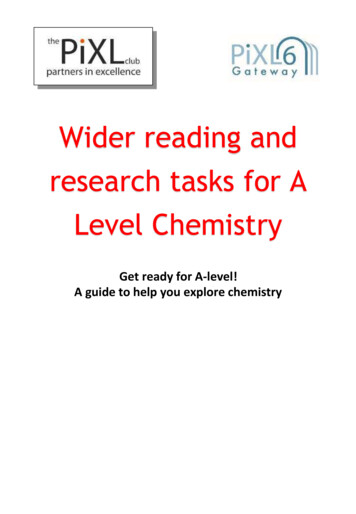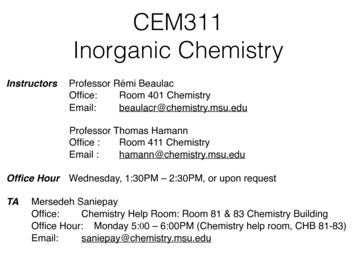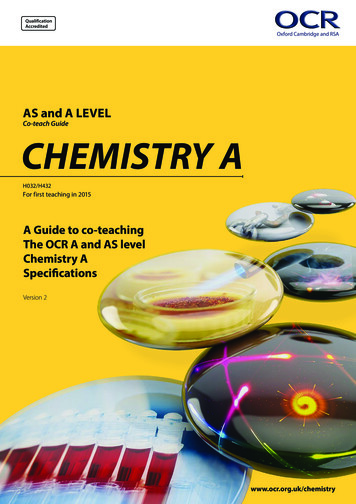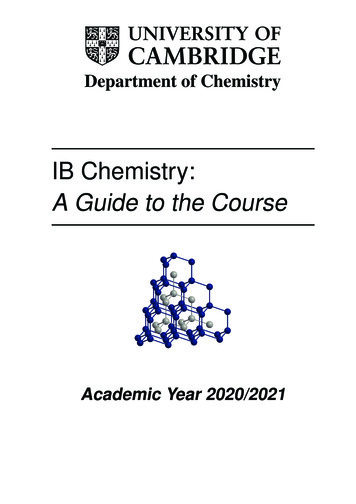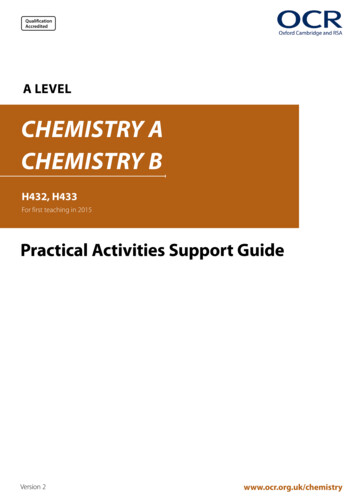
Transcription
QualificationAccreditedA LEVELCHEMISTRY ACHEMISTRY BH432, H433For first teaching in 2015Practical Activities Support GuideVersion 2www.ocr.org.uk/chemistry
A Level Chemistry A and A Level Chemistry BPractical Activities Support GuideContentsIntroduction3PAG vs CPAC and 1.2.15PAG vs 1.2.27PAG 1: Moles determination9PAG 2: Acid-base titration12PAG 3: Enthalpy determination14PAG 4: Qualitative analysis of ions16PAG 5: Synthesis of an organic liquid18PAG 6: Synthesis of an organic solid21PAG 7: Qualitative analysis of organic functional groups23PAG 8: Electrochemical cells25PAG 9: Rates of reaction – continuous monitoring method27PAG 10: Rates of reaction – initial rates method29PAG 11: pH measurement31PAG 12: Research skills33Would you prefer aWord version?Did you know that you can save this pdfas a Word file using Acrobat Professional?Simply click on File Save As Other . . .and select Microsoft Word(If you have opened this PDF in your browser you will needto save it first. Simply right click anywhere on the page andselect Save as . . . to save the PDF. Then open the PDF inAcrobat Professional.)If you do not have access to Acrobat Professional thereare a number of free applications available that will alsoconvert Word to PDF (search for pdf to word converter).2 OCR 2021
A Level Chemistry A and A Level Chemistry BPractical Activities Support GuideIntroductionThis Practical Activities Support Guide is designed to provide support specifically around how our Practical Activity Group (PAG)suggested activities can be adjusted by centres and revision support for our specification’s learning outcomes in 1.1 (Practical skillsassessed in a written examination). This guide supplements our existing resources regarding the Practical Endorsement, including: Positive about Practical This page features videos outlining our PAG approach to the Practical Endorsement. It also contains links tocross-board communications relating to the Practical Endorsement and monitoring. Practical Endorsement FAQs Practical Skills Handbook This is a comprehensive handbook which describes the assessment of practical skills in the AS and A Levelspecifications, including the requirements of the Practical Endorsement and guidance on planning a practical schemeof work.OCR Science Practical Endorsement Training Site Lead teachers are required to have undertaken this free online training and should ensure all other teachers arefamiliar with the requirements. We recommend that, for the purpose of standardisation within your centre, all teacherswho assess the Practical Endorsement undertake the training. PAG teacher and student sheets Science Coordinator Materials This is where secure documents are held including answers for the questions in the PAG student sheets and the PAGtrackers.Specifications (Chemistry A and Chemistry B) Most notably this includes: Module 1.1 Practical skills assessed in a written examinationModule 1.2 Practical skills assessed in the practical endorsementSection 5 Practical Endorsement appendixPAG Practice question setsFor entries into the Summer 2021 series only The Practical Endorsement monitoring process 2019-2021 Additional Practical Endorsement guidance – 2020-2021 Practical Endorsement guidance for remote monitoring3 OCR 2021
A Level Chemistry A and A Level Chemistry BPractical Activities Support GuideThe Practical EndorsementExtract from the Practical Skills Handbook:The Practical Endorsement is directly assessed by teachers and is a mandatory part of the A Level qualification. The assessmentis certificated as Pass or Not-classified. As part of the Head of Centre declaration that centres must submit every year, any centreoffering A Level Chemistry must declare that they have provided students with the opportunity to complete practical work towardsthe Practical Endorsement.In order to achieve a Pass, candidates will need to have met the expectations set out in the Common Practical Assessment Criteria(CPAC) (see Table 2 in the specification, Appendix 5) including demonstrating competence in all the skills, apparatus and techniquesin sections 1.2.1 and 1.2.2 of each specification.Learners may work in groups, but must be able to demonstrate and record independent evidence of their competency. This mustinclude evidence of independent application of investigative approaches and methods to practical work.Teachers who award a Pass need to be confident that the candidate consistently and routinely exhibits the required competenciesbefore completion of the A Level course.The PAG ApproachCandidates can demonstrate these competencies in any practical activity undertaken throughout the course of study. The 12 OCRPractical Activity Groups (PAGs) described in the specification provide opportunities for demonstrating competence in all requiredskills, together with the use of apparatus and practical techniques for each subject.Using our suggested practical activities is not mandatory. You can use the suggested practical activities from the Practical ActivityGroups (PAGs), your own activities, or activities from other publishers to assess student practical skills. If you use activities otherthan our suggested practical activities, you need to ensure that you have mapped these activities to the relevant 1.2.1 and 1.2.2criteria and the CPAC so you can track student progress in these. You are free to make changes to our suggested activities, but ifthese changes change which parts of 1.2.1, 1.2.2 and the CPAC you are assessing you will need to make sure this is reflected in yourtracking of student progress.In the OCR specifications, 12 PAGs are presented. Within each PAG are 3-4 suggested activities. None of these activities are explicitlyrequired. Instead, the PAG approach gives some possible routes for students to learn the practical skills in the AS and A Levelspecifications and to achieve the Practical Endorsement.At least 15% of the marks in examinations will assess practical skills. Examinations will not assume candidates have carried out allof these activities. However, they will assume that students are familiar with specific practical aspects mentioned in modules 2-6(Chemistry A) and section 2d (Chemistry B), as well as those from the 1.2.2 criteria which students will have covered during thecourse of the Practical Endorsement. Questions may test the application of practical skills in novel and familiar contexts.Health and safetyFor additional health and safety guidance, please refer to CLEAPPS.The CPAC and our specificationsThe CPAC criteria is very closely linked to our specification learning outcomes in 1.2.1 Practical skills. Below, we have mapped outhow these learning outcomes map to the CPAC criteria as well as our PAG activities.In addition, we have also mapped out how our PAG activities relate to our specification’s 1.2.2 Use of apparatus and techniqueslearning outcomes.4 OCR 2021
A Level Chemistry A and A Level Chemistry BPractical Activities Support GuidePAG vs CPAC and 1.2.1This table shows how our suggested practical activities in the PAGs relate to both the CPAC and our specification’s 1.2.1 Practical skills learning outcomes.PAG1.2.1CPAC 1:FollowswrittenproceduresCPAC 2: Applies investigativeCPAC 3: Safely uses a rangeapproaches and methodsof practical equipment andwhen using instruments andmaterialsequipmentCPAC 4: Makes and records observationsCPAC 5: Researches, references and reportsc) followwritteninstructionsa) applyinvestigatingapproaches topractical workg) useappropriatesoftwareand tools toprocess data,carry outresearch andreport findingsg) useappropriatesoftwareand tools toprocess data,carry outresearch andreport findingsb) safelyuse a rangeof practicalequipment &materialsj) use a widerange ofexperimentaland practicalinstruments,equipmentandtechniquesd) makeand recordobservations/measurementse) keepappropriaterecords ofexperimentalactivitiesf) presentinformationand data in ascientific way1.1 1.2 1.3 2.1 2.2 2.3 3.1 3.2 3.3 4.1 4.2 4.3 h) use online i) correctlyand offlinecite sources ofresearch skills informationincludingwebsites,textbooks andother printedscientificsources ofinformation5.1 5.2 5.3 5.4 6.1 6.2 5 OCR 2021
A Level Chemistry A and A Level Chemistry BPAG1.2.1Practical Activities Support GuideCPAC 1:FollowswrittenproceduresCPAC 2: Applies investigativeCPAC 3: Safely uses a rangeapproaches and methodsof practical equipment andwhen using instruments andmaterialsequipmentCPAC 4: Makes and records observationsCPAC 5: Researches, references and reportsc) followwritteninstructionsa) applyinvestigatingapproaches topractical workg) useappropriatesoftwareand tools toprocess data,carry outresearch andreport findingsg) useappropriatesoftwareand tools toprocess data,carry outresearch andreport findingsb) safelyuse a rangeof practicalequipment &materialsj) use a widerange ofexperimentaland practicalinstruments,equipmentandtechniquesd) makeand recordobservations/measurementse) keepappropriaterecords ofexperimentalactivitiesf) presentinformationand data in ascientific way6.3 7.1 7.2 7.3 8.1 8.2 8.3 9.1 9.2 9.3 10.1 10.2 10.3 11.1 11.2 h) use online i) correctlyand offlinecite sources ofresearch skills informationincludingwebsites,textbooks andother printedscientificsources ofinformation 11.3 12.1 12.2 12.36 OCR 2021
A Level Chemistry A and A Level Chemistry BPractical Activities Support GuidePAG vs 1.2.2This table shows how our suggested practical activities in the PAGs relate to our specification’s 1.2.2 Use of apparatus and techniques learning outcomes.1.2.2 a) use ofappropriateapparatusto recorda range ofmeasurements(to includemass, time,volumeof liquidsand gases,temperature)1.11.21.32.12.22.33.13.23.3b) useof awaterbath orelectricheateror sandbath forheatingc)measurementof pH usingpH charts, orpH meter, orpH probe ona data logger d)(i)use oflaboratoryapparatusfortitration,using aburetteandpipetted)(ii) use rreflux,includingsetting upglasswareusingretortstand andclamps 4.35.25.35.46.16.26.37.17.27.3e) use of avolumetricflask,includingaccuratetechniquefor makingup astandardsolution f) use ofacid–baseindicatorsintitrationsof weak/strongacids withweak/strongalkalisg)(i)purificationof a solidproduct byrecrystallisationg)(ii)purificationof a liquidproduct,includinguse of aseparatingfunnel.h) use of i) use of thinmeltinglayer or paperpointchromatographyapparatus 4.2 d)(iv)use oflaboratoryapparatusforfiltration,includinguse offlutedfilterpaper, orfiltrationunderreducedpressurej) setting up ofelectrochemicalcells andmeasuringvoltagesk) safely andcarefullyhandlingsolids d toxicsubstancesl)(i)measurementof rates ofreaction byan initial ratemethod suchas a clockreactionl)(ii)measurementof rates ofreaction by acontinuousmonitoringmethod 4.15.1d)(iii)use oflaboratoryapparatusforqualitativetests forions andorganicfunctionalgroups 7 OCR 2021
A Level Chemistry A and A Level Chemistry B1.2.2 a) use ofappropriateapparatusto recorda range ofmeasurements(to includemass, time,volumeof liquidsand gases,temperature)8.18.2b) useof awaterbath orelectricheateror sandbath forheatingc)measurementof pH usingpH charts, orpH meter, orpH probe ona data loggerd)(i)use oflaboratoryapparatusfortitration,using aburetteandpipettePractical Activities Support Guided)(ii) use rreflux,includingsetting upglasswareusingretortstand andclampsd)(iii)use oflaboratoryapparatusforqualitativetests forions andorganicfunctionalgroupsd)(iv)use oflaboratoryapparatusforfiltration,includinguse offlutedfilterpaper, orfiltrationunderreducedpressuree) use of avolumetricflask,includingaccuratetechniquefor makingup astandardsolutionf) use ofacid–baseindicatorsintitrationsof weak/strongacids withweak/strongalkalis 8.39.19.29.310.110.210.311.111.211.312.112.212.3 g)(i)purificationof a solidproduct byrecrystallisationg)(ii)purificationof a liquidproduct,includinguse of aseparatingfunnel.h) use of i) use of thinmeltinglayer or paperpointchromatographyapparatusj) setting up ofelectrochemicalcells andmeasuringvoltagesk) safely andcarefullyhandlingsolids d toxicsubstances l)(i)measurementof rates ofreaction byan initial ratemethod suchas a clockreactionl)(ii)measurementof rates ofreaction by acontinuousmonitoringmethod 8 OCR 2021
A Level Chemistry A and A Level Chemistry BPractical Activities Support GuidePAG 1: Moles determinationSuggested activities1.2.1 practical skills covered1.1: Determination of the composition of copper(II)carbonate basic1.2: Determination of the relative atomic mass ofmagnesium1.2.2 apparatus andtechniques covereda, kb, c, d, e, f, j1.3: Determination of the formula for magnesium oxideaOverviewTechniques/skills covered in this practical activity group (minimum): use of appropriate apparatus to record measurements of mass and volume of a gas, 1.2.2(a)In PAG 1.1, students react a known mass of copper(II) carbonate basic with an excess of sulfuric acid, collecting the carbon dioxidegas that is produced. They then measure the volume of the carbon dioxide and use this to determine the percentage by mass ofcopper(II) carbonate in copper(II) carbonate basic. The apparatus used in this practical activity is shown below:stopper250 cm3 measuring cylinderwaterDuring this procedure, some gas produced will be lost as the stopper is replaced after adding reagents. Additionally, some of thecarbon dioxide will dissolve in the water, so the volume of carbon dioxide collected will be less than expected. Both of these factorslead to the calculated percentage by mass of copper(II) carbonate being smaller than would otherwise be expected.There are some alternatives to the equipment shown above. A Buchner flask may be used instead of a conical flask, with a rubbertube in place of the glass delivery tube. This is easier to handle and less likely to fall over. Additionally, instead of collection of the gasproduced over water, a gas syringe may be used. As most gas syringes measure up to 100 cm3, the masses used in the practical mayneed to be adjusted accordingly.A similar set-up is used for PAG 1.2. In this practical activity, students determine the relative atomic mass of magnesium by reactinga measured mass of magnesium with aqueous sulfuric acid, collecting and measuring the volume of the evolved hydrogen gas.The same equipment alternatives as for PAG 1.1 apply here. As with PAG 1.1, it’s important to insert the stopper as quickly as possibleonce the reagents have been added. Otherwise, a lower total volume of hydrogen gas produced will be recorded, leading to a lowerresult for the relative atomic mass of magnesium than expected.An alternative method for determining the relative atomic mass of magnesium involves reacting magnesium oxide with sulfuricacid, evaporating the resulting solution to obtain magnesium sulfate, and using the mass of the product to calculate the value formagnesium’s relative atomic mass.9 OCR 2021
A Level Chemistry A and A Level Chemistry BPractical Activities Support GuideIn PAG 1.3, students determine the empirical formula for magnesium oxide by accurate measurements of the mass of a sample ofmagnesium, heating in air to form magnesium oxide, and then accurately measuring the mass of the product. The apparatus usedfor this practical are shown below:cruciblemagnesiumribbonclay pipe triangleNote that, unlike PAGs 1.1 and 1.2, this activity does not cover measurement of the volumes of gas (1.2.2k).The lift of the crucible must be briefly lifted at intervals during the procedure to allow sufficient oxygen to enter and react withthe magnesium. Incomplete reaction of the magnesium leads to a lower than expected value for oxygen in the empirical formuladeduced.Possible adjustmentsA CLEAPSS alternative to PAG 1.3 is provided by OCR and is also available here: inding-the-Formula-of-Magnesium-Oxide.aspx. This microscale alternative uses metal bottle caps tied together with nichromewire, within which the magnesium is placed. The gaps between the bottle caps allow entry of oxygen without the loss of reactionmaterial, giving a more accurate result.1.2.1(h) (using online and offline research skills) and 1.2.1(i) (correctly citing sources of information) could be met by adding aresearch element to this practical. This could involve researching alternative methods.An alternative method for determining the relative atomic mass of magnesium (PAG 1.2) involves reacting magnesium oxide withsulfuric acid, evaporating the resulting solution to obtain magnesium sulfate, and using the mass of the product to calculate thevalue for magnesium’s relative atomic mass. 1.2.2(g)(i) (purification of a solid product by recrystallisation) could be met using thismethod, as the magnesium sulfate would need to be recrystallised.1.2.2(l)(ii) (measuring rate of reaction by a continuous monitoring method) could be met as part of PAG 1.1 or 1.2 by continuousmonitoring of the evolution of gas during the reaction to determine the rate.1.2.2(a) (use of appropriate apparatus to record measurements of mass and volume of a gas) can also be met in a number of ourother suggested practical activities (for example, in PAG 9).10 OCR 2021
A Level Chemistry A and A Level Chemistry BPractical Activities Support GuideSupport resourcesThe following resources may be useful as revision aids for your students to remind them of the practical procedures used in this PAG. VIDEO: Dept. of Chemistry & Biochemistry, San Diego State University: Practical procedure for PAG 1.3:https://www.youtube.com/watch?v OuFqtxZJRvMThis video shows the procedure provided in PAG 1.3. It also includes an additional step of adding a small amount of wateronce the reaction is complete and then continuing to heat the crucible. This ensures a more complete reaction and alsoremoves any magnesium nitride that may have formed by converting it to ammonia, allowing the magnesium to react withoxygen. This gives a more accurate result. VIDEO: MaChemGuy: Questions relating PAG 1:https://www.youtube.com/watch?v 4eTbOod4tcYThis video examines example questions relating to the practical activities in PAG 1, discusses methods and provides workedanswers. VIDEO: David Read, University of Southampton: Using a gas syringe to measure volumes of gases:https://www.youtube.com/watch?v IC0LNR37THsThis video uses the example of the reaction of marble chips with hydrochloric acid to show how a gas syringe can be usedto measure the volume of gas produced by a reaction. VIDEO: David Read, University of Southampton: Collecting gases produced in chemical reactions:https://www.youtube.com/watch?v nOcupIk-mnYA quick video which demonstrates how to collect a gas from a reaction using the collection over water method. ALTERNATIVE PRACTICAL: Education in Chemistry: Finding the formula of copper(II) rmula-of-copperii-oxide/727.articleThis activity involves heating copper(II) oxide in a glass tube while passing methane over it. The copper(II) oxide is reducedto copper and by weighing the reactants and the products students can deduce the formula of copper(II) oxide. ALTERNATIVE PRACTICAL: Education in Chemistry: Finding the formula of hydrated copper(II) In this activity a known mass of hydrated copper(II) sulfate is heated to remove the water of crystallisation and various massreadings allow the formula to be determined.11 OCR 2021
A Level Chemistry A and A Level Chemistry BPractical Activities Support GuidePAG 2: Acid-base titrationSuggested activities1.2.1 practical skills covered2.1: Determination of concentration of hydrochloric acid2.2: Determination of the molar mass of an acid1.2.2 apparatus andtechniques covereda, d(i), e, fb, c, d, e, f, ja, d(i), e, f, k2.3: Identification of an unknown carbonateOverviewTechniques/skills covered in this practical activity group (minimum): measurement of volume of a liquid, 1.2.2(a) use of volumetric flask, including accurate technique for making up a standard solution, 1.2.2(e) use of laboratory apparatus for titration, using burette and pipette, 1.2.2(d)(i) use of acid–base indicators in titrations of weak/strong acids with weak/strong alkalis, 1.2.2(f )In PAG 2.1, students make up a standard solution of sodium hydrogencarbonate and then titrate this against a solution ofhydrochloric acid in order to work out the concentration of the acid.In PAG 2.2, students make up a solution of an unknown hydrated acid (citric acid monohydrate), then titrate against sodiumhydroxide solution of known concentration. From their results, they determine the molar mass of the acid, and with additionalinformation, the formula of the acid.In PAG 2.3, students make up a solution of an unknown Group 1 carbonate, and then titrate this solution against hydrochloric acid.From their results they determine the molar mass of the carbonate and hence the identity of the metal.There are numerous opportunities throughout these practical activities to calculate the uncertainty in readings from apparatus. Fullguidance on calculating uncertainties is available in the Practical Skills Handbook (p39-41). Questions to allow students to practicethese are provided in the student sheets to accompany the practical activities, with trial results and worked answers provided in theteacher and technician sheets.Volumetric pipettes are used to transfer solutions when carrying out a titration. These have a smallerassociated uncertainty, leading to more accurate results.When taking burette readings, the reading should be taken from the bottom of the meniscus, as shownin the diagram to the left. When filling volumetric pipettes, they should be filled so that the bottom of themeniscus sits on the line which indicates where it should be filled to.Burettes are rinsed with the substance they will be filled with prior to filling them. Otherwise, residualsubstances may lower the concentration of the substance the burette is being filled with. This would leadto a larger titre being recorded, reducing accuracy.The burette’s tap space should also be filled before the titration starts. Failure to do this means a larger titrewill be recorded as this space will fill first before the solution comes out of the burette.An indicator is commonly used to show when a titration is completed. Only a few drops should be added,as otherwise the indicator can affect the titre values recorded (this is because they are usually weak acidsor bases).Titrations should be repeated until concordant results are obtained (titres within 0.1 cm3 of each other). The mean titre should becalculated from concordant results only and trial results should not be included.12 OCR 2021
A Level Chemistry A and A Level Chemistry BPractical Activities Support GuidePossible adjustmentsAll of these suggested practical activities could be truncated to simply involve the making up of a standard solution, 1.2.2(e), ifadditional opportunities to practise this specific skill are needed. Similarly, for a shorter practical activity which offers additionalpractice of titration techniques, 1.2.2(d)(i), the making up of a standard solution could be omitted (though it would still need to becovered elsewhere).1.2.1(h) (using online and offline research skills) and 1.2.1(i) (correctly citing sources of information) could be met by adding aresearch element to this practical. This could involve researching methods prior to carrying out practical work.CLEAPSS offer an alternative practical activity involving the microscale titration of vinegar. This activity may be useful if you havelimited titration equipment or if you have need for a practical activity which can be conducted outside a laboratory setting. While1.2.2(d)(i) (use of laboratory apparatus for titration) could not be met using this procedure, it would still allow for students to meet1.2.2(a) (measurement of volume of a liquid) and 1.2.2(f ) (use of acid–base indicators). They would also still be able to meet the 1.2.1criteria that our own suggested practical activities map to.Support resourcesThe following resources may be useful as revision aids for your students to remind them of the practical procedures used in this PAG. RESOURCED LESSON OUTLINE: Cambridge International Resource Plus: An acid-base volumetric org/classroom/course/view.php?id 3630This resourced lesson outline includes a video and teacher walkthrough of the techniques, a teaching pack of resources,and an associated quiz. SIMULATION: Royal Society of Chemistry: Titration screen -screen-experiment/2077.articleThis interactive resource allows students to simulate a titration procedure. This includes both acid-base and redox titrationexamples. Teacher notes are included. VIDEOS: MaChemGuy: How to do an acid-base titration:Part 1: https://www.youtube.com/watch?v jnG9Ut--yUAPart 2: https://www.youtube.com/watch?v UAkibS8DOqYThese videos walk through the process for carrying out a titration, including worked examples of the subsequentcalculations. INFOGRAPHIC: Compound Interest: Chemistry techniques: titration/This infographic gives a quick overview of the apparatus and procedures used during a titration. VIDEO: David Read, University of Southampton: Carrying out a titration:https://www.youtube.com/watch?v Y-5QJIr7Xm4An additional video illustrating the techniques required when carrying out a titration. ALTERNATIVE PRACTICAL: Education in Chemistry: Thermometric tric-titration/429.articleThis activity requires students to measure the maximum temperature reached in the reaction between hydrochloric acidand sodium hydroxide in order to determine the end point of the titration. There are also potential links here to PAG 3(enthalpy determination), as this method could also be used to calculate the enthalpy of neutralisation.13 OCR 2021
A Level Chemistry A and A Level Chemistry BPractical Activities Support GuidePAG 3: Enthalpy determinationSuggested activities1.2.1 practical skills covered1.2.2 apparatus andtechniques coveredb, c, d, e, f, ja, k3.1: Determination of the enthalpy change of neutralisation3.2: Determination of an enthalpy change of reaction by Hess’law3.3: Determination of enthalpy changes of combustionOverviewTechniques/skills covered in this practical activity group (minimum): use of appropriate apparatus to record measurements of temperature, 1.2.2(a)In PAG 3.1, students use calorimetry to measure the temperature change when hydrochloric acid and sodium hydroxide solutionare mixed. From their results they calculate the enthalpy change of neutralisation.In PAG 3.2, students determine the enthalpy change of reaction by Hess’ Law using experimental evidence. This involves measuringthe temperature changes in the reactions of both K2CO3 and KHCO3 with hydrochloric acid and applying knowledge of Hess’ Law tocalculate the enthalpy change of thermal decomposition of KHCO3.In PAG 3.3, students determine the enthalpy change of combustion of alcohols. This involves measuring the mass of the alcoholcombusted, the mass of the water heated and the temperature change.These suggested practical activities all offer ample opportunities for the discussion of how experimental limitations can affect results.These can include, but are not limited to: Energy losses from containers used to carry out reactions Incomplete combustion (in PAG 3.3) Variations in the value of specific heat capacity (the specific heat capacity for water is used generally, but the true value maydiffer slightly in the case of solutions) and in the density of solutions from that of pure water Deviation from standard conditionsStudents could be expected to suggest improvements which would mitigate the effects of some of these limitations, whereappropriate.When calculating the enthalpy change for a reaction where a solid is added to a solution, the masses of the solid and the solutionshould be summed if the solid subsequently forms part of the solution (that is, if it fully dissolves or reacts). This is the approach usedin the written examinations unless a question states otherwise.Possible adjustmentsIn PAG 3.3, students do not have to carry out the activity for a range of alcohols if this is not practical – they can still meet thecriteria assessed in this activity by carrying it out with a single alcohol. This may help if you need to carry out this activity in a shortertime period or with limited equipment.For PAG 3.1 and 3.3, the opportunity to process the data gained on the enthalpy changes of could also be provided. This wouldallow coverage of 1.2.1(g) (use appropriate software and tools to process data).1.2.1(h) (using online and offline research skills) and 1.2.1(i) (correctly citing sources of information) could be met by adding aresearch element to this practical. This could involve researching methods prior to carrying out practical work, or looking up andappropriately referencing literature enthalpy values.14 OCR 2021
A Level Chemistry A and A Level Chemistry BPractical Activities Support GuideSupport resourcesThe following resources may be useful as revision aids for your students to remind them of the practical procedures used in this PAG. RE
A Level Chemistry A and A Level Chemistry B Practical Activities Support Guide PAG vs 1.2.2 This table shows how our suggested practical activities in the PAGs relate to our specification's 1.2.2 Use of apparatus and techniques learning outcomes. 1.2.2 a) use of appropriate apparatus to record a range of measurements (to include mass, time .


